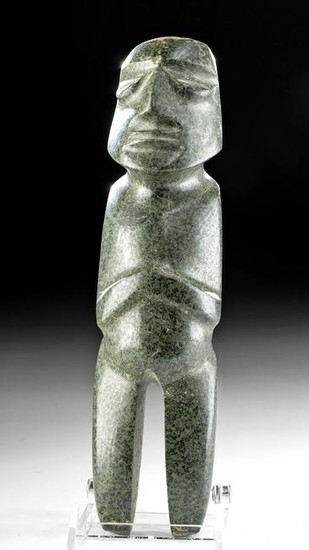Exhibited Guerrero Mezcala Diorite Figure - Type M-26
Pre-Columbian, southern Mexico, Guerrero region, Mezcala culture, ca. 500 to 200 BCE. A fantastic example of a stylized anthropomorphic axe god figure of the characteristically unusual M-26 type, hand-carved from mottled grey-green diorite with black inclusions. The figure bears a slightly distended lower abdomen with blocky arms held gently on top, delineated legs that taper to blunt lower edges, and string-cut clefts denoting the sloped neck and waistline. The enlarged head exhibits protruding eyes and lips typical of earlier Chontal effigies; however the crested nose, gently plateaued brow, and bulbous forehead are distinctly of Mezcala stylization. Lucite display stand for photography purposes only. Size: 2.375" W x 9.375" H (6 cm x 23.8 cm)
According to author and Guerrero/Mezcala/Chontal expert Dr. Carlo Gay, "The M-26 type, seemingly a paradox in the Mezcala tradition of making effigies, represent a radical departure from the ways of interpreting the human form as exemplified by the preceding twelve types. More observant of the human anatomy, the carvers experimented with rounded volumes and added details to achieve a greater degree of naturalism than ever before attempted in the course of the tradition." (Gay, Carlo and Frances Pratt. "Mezcala: Ancient Stone Sculpture from Guerrero Mexico." Balsas Publications, Geneva, 1992, p. 97). Dr. Gay also explains how, regarding the similarities of this typology to earlier Chontal effigies, "Type M-26 is clearly hybrid in that the treatment of the facial features is shared by a distinctive kind of Chontal type having 'coffee-bean' eyes and a slit mouth. The placement of this type at the end of the seriation is directed by its greater naturalism as compared with the more abstract interpretation of the human form in the preceding twelve [types]." (Gay, Carlo and Frances Pratt. "Mezcala: Ancient Stone Sculpture from Guerrero Mexico." Balsas Publications, Geneva, 1992, p. 100)
Exhibited in the University of St. Thomas Art Gallery.
For two stylistically similar examples of Type M-26 figures, please see: Gay, Carlo and Frances Pratt. "Mezcala: Ancient Stone Sculpture from Guerrero Mexico." Balsas Publications, Geneva, 1992, p. 96, fig. 13 and p. 98, plate 82.
Provenance: ex-private collection of the late Father Bader, University of St. Thomas, Houston, Texas, USA; exhibited in the University of St. Thomas Art Gallery, acquired prior to 2000
All items legal to buy/sell under U.S. Statute covering cultural patrimony Code 2600, CHAPTER 14, and are guaranteed to be as described or your money back.
A Certificate of Authenticity will accompany all winning bids.
We ship worldwide to most countries and handle all shipping in-house for your convenience.
#154281
Condition Report: Minor abrasions to legs, body, and head, with light softening to some finer details, light encrustations, and minor pecking to top of head, otherwise intact and near-choice. Light earthen deposits and smooth surface texture throughout.
View it on
Sale price
Estimate
Time, Location
Auction House
Pre-Columbian, southern Mexico, Guerrero region, Mezcala culture, ca. 500 to 200 BCE. A fantastic example of a stylized anthropomorphic axe god figure of the characteristically unusual M-26 type, hand-carved from mottled grey-green diorite with black inclusions. The figure bears a slightly distended lower abdomen with blocky arms held gently on top, delineated legs that taper to blunt lower edges, and string-cut clefts denoting the sloped neck and waistline. The enlarged head exhibits protruding eyes and lips typical of earlier Chontal effigies; however the crested nose, gently plateaued brow, and bulbous forehead are distinctly of Mezcala stylization. Lucite display stand for photography purposes only. Size: 2.375" W x 9.375" H (6 cm x 23.8 cm)
According to author and Guerrero/Mezcala/Chontal expert Dr. Carlo Gay, "The M-26 type, seemingly a paradox in the Mezcala tradition of making effigies, represent a radical departure from the ways of interpreting the human form as exemplified by the preceding twelve types. More observant of the human anatomy, the carvers experimented with rounded volumes and added details to achieve a greater degree of naturalism than ever before attempted in the course of the tradition." (Gay, Carlo and Frances Pratt. "Mezcala: Ancient Stone Sculpture from Guerrero Mexico." Balsas Publications, Geneva, 1992, p. 97). Dr. Gay also explains how, regarding the similarities of this typology to earlier Chontal effigies, "Type M-26 is clearly hybrid in that the treatment of the facial features is shared by a distinctive kind of Chontal type having 'coffee-bean' eyes and a slit mouth. The placement of this type at the end of the seriation is directed by its greater naturalism as compared with the more abstract interpretation of the human form in the preceding twelve [types]." (Gay, Carlo and Frances Pratt. "Mezcala: Ancient Stone Sculpture from Guerrero Mexico." Balsas Publications, Geneva, 1992, p. 100)
Exhibited in the University of St. Thomas Art Gallery.
For two stylistically similar examples of Type M-26 figures, please see: Gay, Carlo and Frances Pratt. "Mezcala: Ancient Stone Sculpture from Guerrero Mexico." Balsas Publications, Geneva, 1992, p. 96, fig. 13 and p. 98, plate 82.
Provenance: ex-private collection of the late Father Bader, University of St. Thomas, Houston, Texas, USA; exhibited in the University of St. Thomas Art Gallery, acquired prior to 2000
All items legal to buy/sell under U.S. Statute covering cultural patrimony Code 2600, CHAPTER 14, and are guaranteed to be as described or your money back.
A Certificate of Authenticity will accompany all winning bids.
We ship worldwide to most countries and handle all shipping in-house for your convenience.
#154281
Condition Report: Minor abrasions to legs, body, and head, with light softening to some finer details, light encrustations, and minor pecking to top of head, otherwise intact and near-choice. Light earthen deposits and smooth surface texture throughout.



